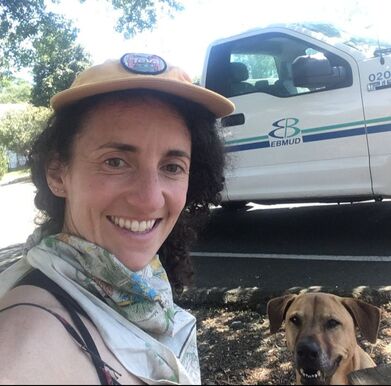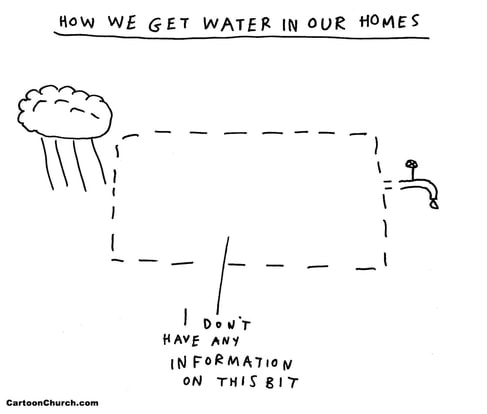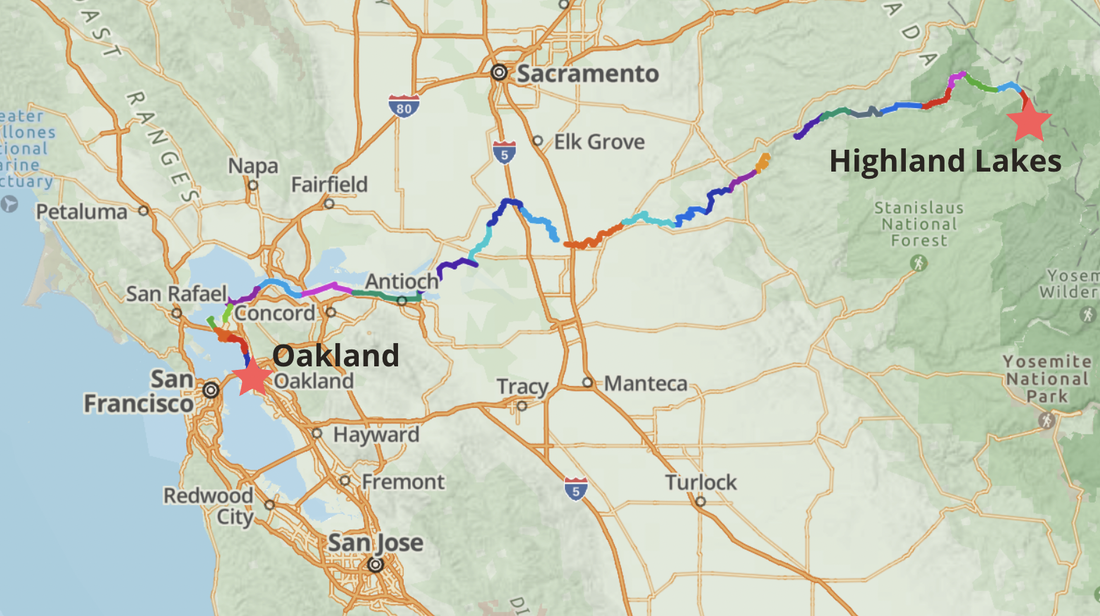DETAILS OF THE JOURNEY
>240 miles: Oakland to Highland Lakes
1 month: July 2022
1 woman: Nina Gordon-Kirsch
1 dog: Petey
A Film Crew: Marielle Olentine, Julia Maryanska, Sky Richards, and Mer Al'Dao
Goal: Tracing the Mokelumne River and making a film to educate East Bay residents about where their water comes from.
1 month: July 2022
1 woman: Nina Gordon-Kirsch
1 dog: Petey
A Film Crew: Marielle Olentine, Julia Maryanska, Sky Richards, and Mer Al'Dao
Goal: Tracing the Mokelumne River and making a film to educate East Bay residents about where their water comes from.
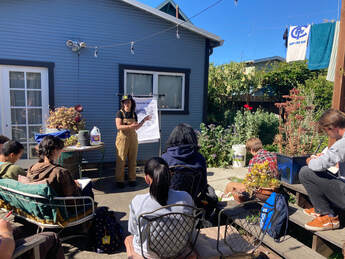
The Educational Curriculum
We are working on creating a 35 minute film that documents the water walk and shows where East Bay water comes from.
The film team came and found me on the walk at pivotal moments and recorded the journey. I also filmed myself everyday to document my surroundings, feelings and reflections.
Once the film is done, we will have public showings and bring the film into East Bay schools.
It’s important for all people to know where their water comes from.
And if people learn at an early age where their water comes from and how to care for it, we will have a next generation of eco-literate citizens who can help solve climate change. The most devastating effects of climate change - fires, floods, drought, sea level rise - are caused by not caring for the waters.
It is imperative that the next generation learns to be water protectors, and that starts with learning where their water comes from.
High school is a very formative time - it’s the time when youth start to choose where to focus their professional interests. These students can be inspired to become policy makers, water law litigators, innovators, and more - to help change the water systems of California.
Join us and support this journey!
We are working on creating a 35 minute film that documents the water walk and shows where East Bay water comes from.
The film team came and found me on the walk at pivotal moments and recorded the journey. I also filmed myself everyday to document my surroundings, feelings and reflections.
Once the film is done, we will have public showings and bring the film into East Bay schools.
It’s important for all people to know where their water comes from.
And if people learn at an early age where their water comes from and how to care for it, we will have a next generation of eco-literate citizens who can help solve climate change. The most devastating effects of climate change - fires, floods, drought, sea level rise - are caused by not caring for the waters.
It is imperative that the next generation learns to be water protectors, and that starts with learning where their water comes from.
High school is a very formative time - it’s the time when youth start to choose where to focus their professional interests. These students can be inspired to become policy makers, water law litigators, innovators, and more - to help change the water systems of California.
Join us and support this journey!
About Me
Hi! My name is Nina and water has been a through line in my life.
I was born and raised on Lisjan Ohlone land in Berkeley, California. Similar to many urban residents, I spent most of my life using water on a daily basis and I had no idea where it came from or how it got to me.
Ever since I left home at ago 18, I've had work and schooling that has helped me answer this question.
Hi! My name is Nina and water has been a through line in my life.
I was born and raised on Lisjan Ohlone land in Berkeley, California. Similar to many urban residents, I spent most of my life using water on a daily basis and I had no idea where it came from or how it got to me.
Ever since I left home at ago 18, I've had work and schooling that has helped me answer this question.
After a decade of traveling the world and studying water systems, I landed back in the Bay Area and have had a number of jobs in the water sector:
Greywater Action - I apprenticed for 3 years and then went to LA to become a CA certified greywater installer. I also lead workshops teaching people how to retrofit their laundry machines to send greywater to their backyard to irrigate their fruit trees and perennial plants.
Backyard Permaculture Guild - a collective I founded to design and install eco-friendly back and front yards, including greywater installations.
California State Water Quality Control Board - I worked in the watershed division, monitoring water reuse projects in the San Francisco Bay Area.
Walking Water - a collective that helps people build relationship to water and listen to what the water needs, instead of just using and manipulating it to benefit humans.
Friends of the River - I went through a River Advocacy Training school, which taught me about political activism and river protection policy, and I also got to attend raft guide training school on the S. Fork of the American River.
Rose Foundation, - I volunteered to train and support high school students in Oakland to present about drinking water issues in their local science classes.
Greywater Action - I apprenticed for 3 years and then went to LA to become a CA certified greywater installer. I also lead workshops teaching people how to retrofit their laundry machines to send greywater to their backyard to irrigate their fruit trees and perennial plants.
Backyard Permaculture Guild - a collective I founded to design and install eco-friendly back and front yards, including greywater installations.
California State Water Quality Control Board - I worked in the watershed division, monitoring water reuse projects in the San Francisco Bay Area.
Walking Water - a collective that helps people build relationship to water and listen to what the water needs, instead of just using and manipulating it to benefit humans.
Friends of the River - I went through a River Advocacy Training school, which taught me about political activism and river protection policy, and I also got to attend raft guide training school on the S. Fork of the American River.
Rose Foundation, - I volunteered to train and support high school students in Oakland to present about drinking water issues in their local science classes.
Spring 2022 was my sixth year co-teaching a CA Water Resources class called Cal Studies-Water at Urban, a private high school in San Francisco. Time and time again, my students tell me how impactful it was for them to learn about where their water comes from. Many of the students who take this water class go on to study and work in the water world; previous students have become policy makers, water regulators, litigators for contaminated water sources, founded businesses to find and fix water leaks, and more. I am so grateful that the private school I work at funds the class I teach and it’s my dream (through the documentary we will make) to bring this kind of education into public schools.
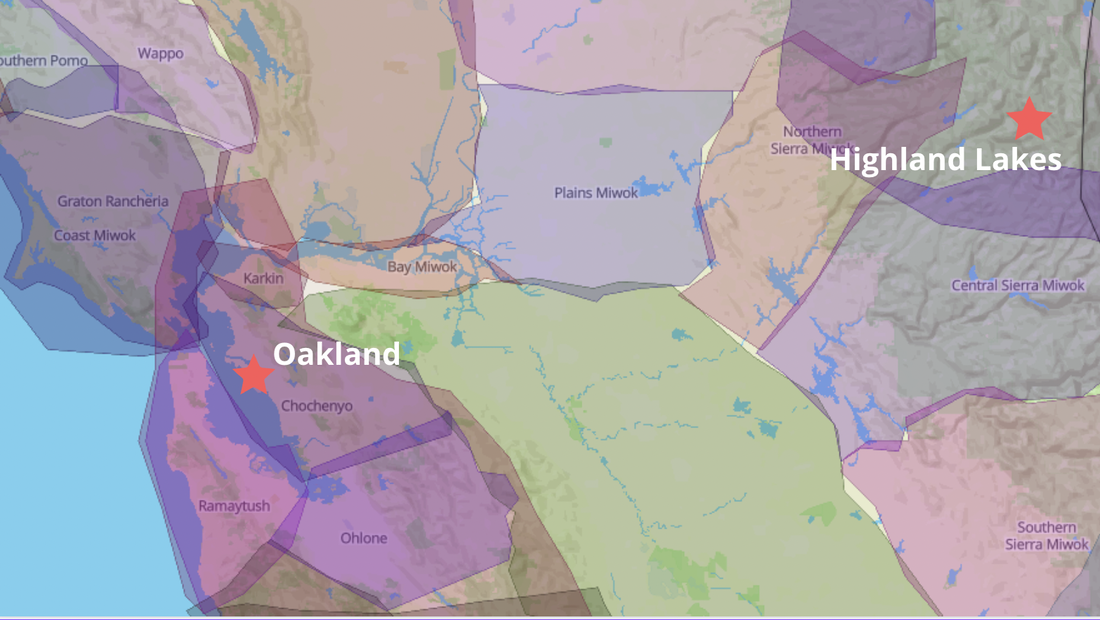
About the Walk
I started the walk with the new moon on June 28th and it took me 33 days. I arrived at Highland Lakes just after the next new moon.
Part one of the walk was from Oakland to Pardee Reservoir - where our water is stored before it’s piped to us. Part two of the walk went up to find the wild waters - where the water isn’t owned or controlled by humans, but instead runs free.
While I had originally planned to backpack my way up, a herniated disc in my low spine last year has altered my plan. Instead, I walked with a daypack each day and had logistical support to bring my sleeping items and food resupply to me each night. Because of the support, the journey included many more people and word of the walk rippled out to even more people. Off and on, I had some company on the trail - other water walkers who felt called to join would come walk for a day or two and my dog, Petey, joined for parts of the journey.
I asked permission from Corrina Gould, of the Chochenyo Ohlone people, to walk on her and her ancestors' land, and I asked permission of the indigenous people of the lands along the whole route. I also asked farmers and other landowners if I could walk across their private land.
I walked in the heat of summer through the Delta and Central Valley.
Most of my trip was walking in the 90s and a few days it got over 100 degrees. I truly learned how holy and life-sustaining water is.
I got up before the sun to walk the bulk before the heat.
I walked on trails, streets, highways, and swam across river crossings.
Want to check out the journey? My team and I posted on Instagram every day of the trek! Take a look at my posts from the summer:
Follow me on Instagram at @Nina.GK
Proudly powered by Weebly
